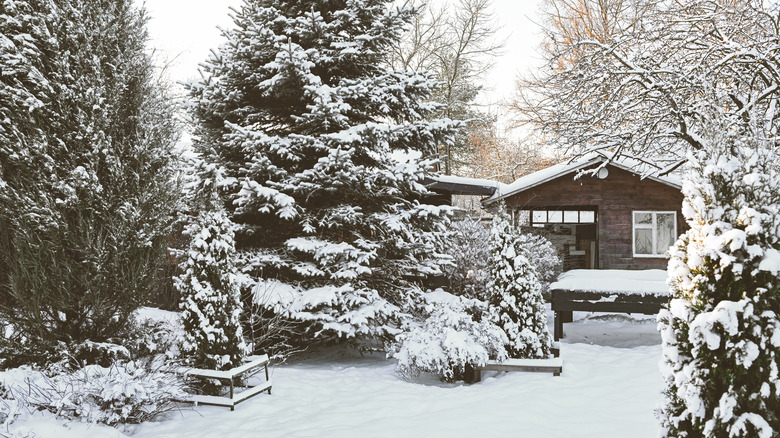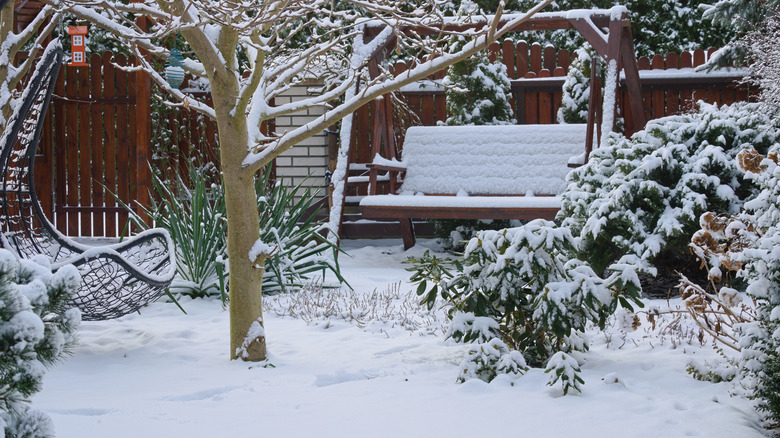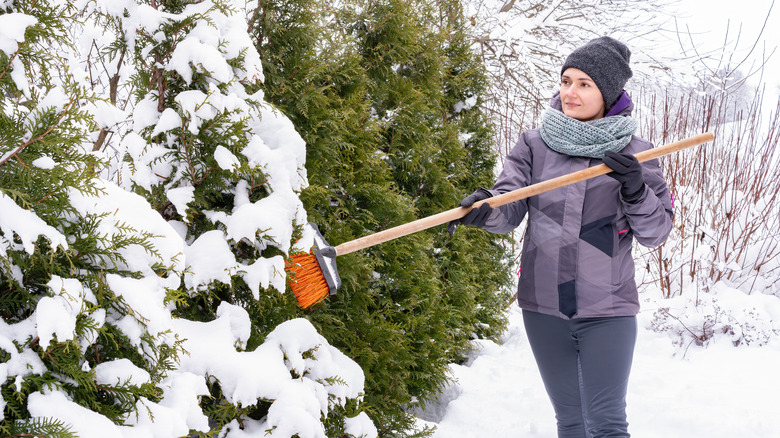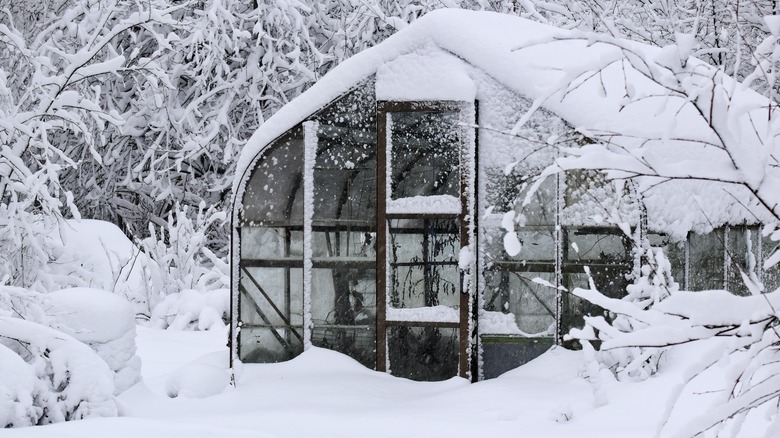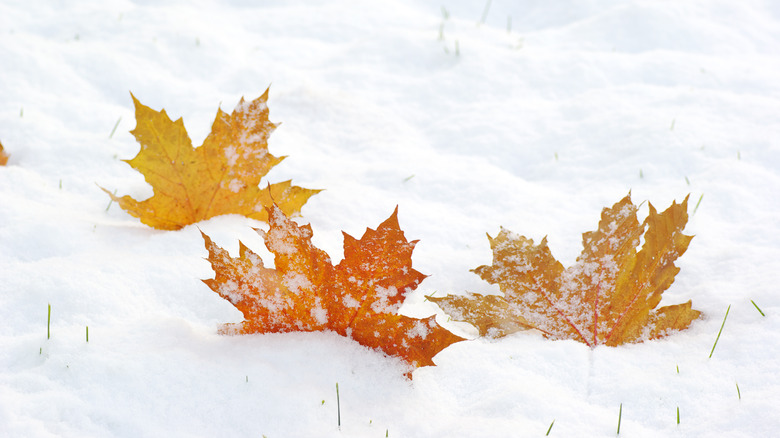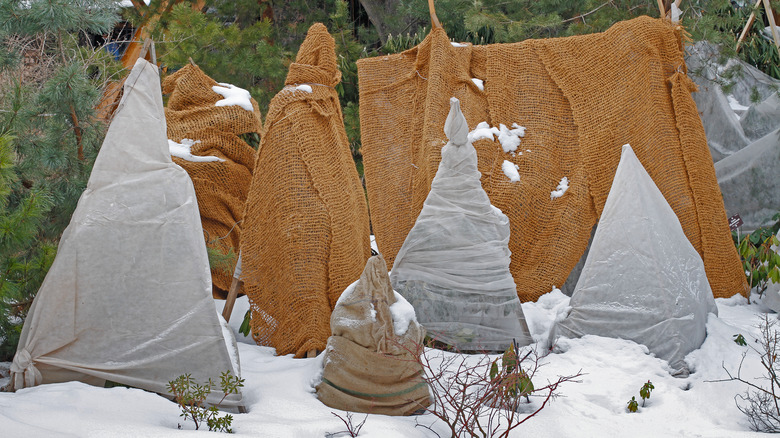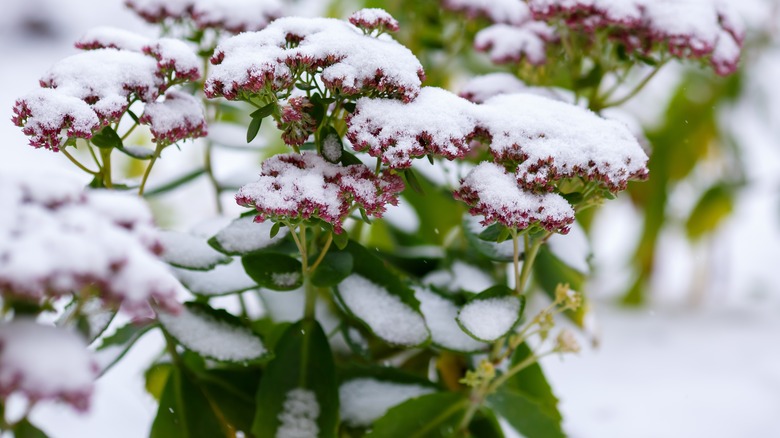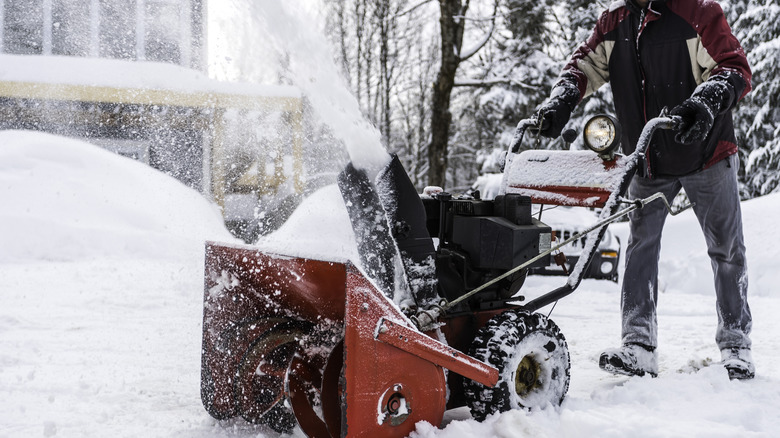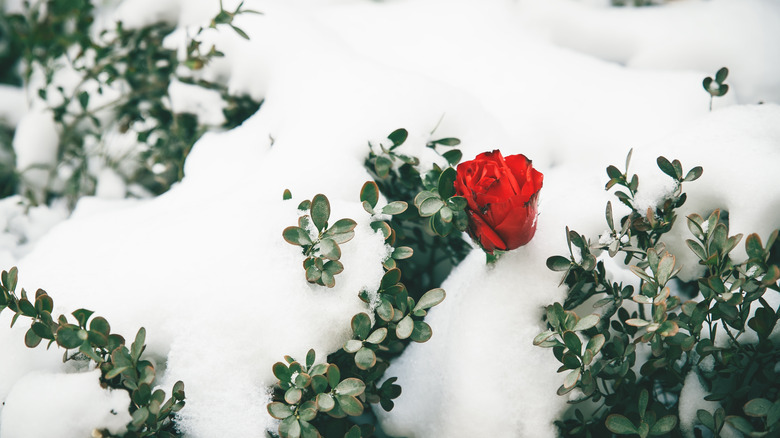Simple Ways To Help Keep Your Garden In Good Shape After A Snowstorm
There's nothing quite like a bit of snow. The powdery white stuff can transform the world. When all is frozen, still, and calm, your garden can look like something out of a fairytale. However, beneath that heavenly and peaceful blanket of frozen flakes, all is often not well, and your plants, shrubs, and trees could be suffering. What's great for skiing on, making epic snowmen out of, and having snowball fights with is not always so great for your garden.
When the snow storms, the cold winds blow, and the ground freezes, it can cause a bucket load of damage to your garden. Widespread rot, ruin, and the gradual decay of plants and shrubs you have spent a lot of time lovingly nurturing is a common occurrence after a bitter and prolonged storm. However, when Jack Frost finally quits his nonsense, there are a lot of things you can do to whip your garden back into shape. So put on your boots and wrap up warm — we're going to war against the elements!
Do not walk on the lawn
After a giant snowstorm that leaves the whole neighborhood blanketed in white, you might be tempted to take a casual stroll on your freshly powdered lawn just for the novelty of seeing your footsteps in the snow. But don't! It could cause compaction, which can hurt your grass come springtime.
Healthy soil is filled with air pockets that leave space for water to circulate easily and for air to reach the roots. The heaviness and coldness of the snow, particularly when crushed against the ground by human feet, can cause the soil to harden and squish together, making it hard for water and air to circulate. This can lead to your grass struggling to grow in the spring. Where there were once green and vibrant blades, you might find compaction has reduced them to straw-like and withered specimens. In the worst-case scenario, the compaction will trigger the lawn-destroying disease Fusarium, and then you'll have a real battle on your hands. You can avoid all this by keeping your lawn well-aerated and not frolicking across it in the snow.
Tend to any broken branches or damaged growth
Any self-respecting snowstorm is capable of freezing rivers, halting traffic, canceling flights, and cutting off electric supplies. Naturally, when those icy and vicious legions come calling, it's only to be expected they're going to break a branch or two or interfere with the growth of some of your shrubs. It's important in the face of such wanton damage you put things right as soon as possible. After all, no trees or shrubs are immune to breaking and bending under the combined weight of all that snow and ice.
You should gently and carefully brush off any branches that are weighted down by heavy snowfall. However, be cautious — by trying to remove the snow, you can easily break them in their weakened state. If there is only a light covering, a gentle shake will do the trick to help with the thawing process. A broken branch is easy to spot on the ground and can easily be dragged out of harm's way. Prune brack any snapped branches down to the trunk, which will heal by springtime. However, don't try to shake loose broken branches from a tree when standing beneath. At best, you could get covered in snow, and at worst, a heavy branch could seriously injure you. Never try to scale the tree in an attempt to remove broken limbs either, because that too can lead to potential harm.
Remove any snow from your greenhouse
Who doesn't love a good greenhouse? These magical little huts of glass, heat, and light can help you cultivate your own microclimate and grow a dazzling array of fruit, vegetables, and exotic plants. Yet unlike houses, these little huts of temperature and humidity are not made to stand up under the weight of heavy snow. If you let the white stuff linger on your greenhouse for too long, you risk the chance of collapse. Additionally, the longer you leave snow to settle on your garden structure, the more it'll interfere with its inherent purpose to conserve heat for the benefit of everything that grows within.
If you have a state-of-the-art greenhouse with gutters and a heating pipe installed, you can simply flick a switch to melt the frozen flakes. The gutters will take care of the meltwater. However, if like most people, your greenhouse only radiates a little heat, and you have no fancy heating system, the snow will accumulate. Remove any excess snowfall with a brush or pole after a heavy snowstorm to ensure your garden structure survives the winter.
Clear up leaves
When leaves are sitting pretty on the branch of a tree and dappled in the lazy sun of July, they can make the whole world seem green, promising, and full of potential. Yet when they lay fallen on the floor, brown, withered, and a pale imitation of their former glory, it's time to remove them from your garden and place them in the compost before the first snowfall. If the leaves are still on the ground when they're covered in a blanket of white, they'll turn into a soggy and mulchy mess by the time it thaws.
Not only can leaving excess leaves to decompose in your garden look unsightly, but it can also throw the nutritional balance in your grass and perennials off kilter and can also cause plant disease. Additionally, leaves that are left to rot beneath an aesthetically pleasing layer of snow can cause a dangerously slippery surface when the white stuff melts. This can make you slip when you're fast-footing it around your garden, trying to whip it into shape.
Keep your plants protected
As the mists of autumn fade into another stark and unforgiving winter, preparation is key if you want to keep your garden safe and secure from the dipping temps and harsh weather. Kicking your garden back into shape after a snowstorm is so much easier if you've already put a solid defense system in place. And that involves protecting your vulnerable plants like their lives depended upon it, particularly when there's a heavy downfall forecast.
Existing plants that have been around the track a few times and are firmly established do not require the same level of protection as vulnerable perennials, plants from more exotic regions, or anything that hasn't been in the ground all that long. To avoid those gorgeous blooms of summer wasting away permanently, your best bet is to have a handy supply of protective and lightweight horticultural fleece ready to wrap your plants up snugly in. Made from polyester, the soft fleece can be wrapped around plants to insulate them from the storm. Many people make the mistake of thinking that plastic sheeting is a good substitute, but it does not have the porous quality of horticultural fleece and can suffocate your plants. Bubble wrap will also work well when protecting your plants.
Keep a close eye on your succulents
Depending on where they live, many people tend to bring their succulents indoors at the end of September to protect them from winter's trials and tribulations. No matter what precautions you put in place, there's no way a tender succulent can survive a snowstorm. However, more hearty and hardy succulents built to withstand the barren months, such as Sempervivums, can add a touch of vibrancy and color to your garden in a season when you need it most. Yet even the most stoic succulent sometimes falls prey to the bitter whims and fickle fancies of Jack Frost.
If your succulents are showing signs of frostbite after a snowstorm, you need to act fast and bring them in from the cold and let them dry out for a period. Frostbite manifests itself in discolored and rotting patches where the cells of the plants have broken down due to the extreme temperatures. Be careful not to water the succulent as the frostbite dries out. Once it has scabbed over, cut all parts of the affected plant off. If it has spread to the stem, then it's probably time to abandon all hope. However, if your succulent is showing signs of recovery, it won't be long before you can plant it back in the garden.
Do not use a snow blower to clear the white stuff
Once the frozen flakes have fallen from the sky and your garden lies waiting for someone with a snow blower to come clear the worst of it, you might be tempted to go in guns blazing, but don't! By blowing the snow around with unnatural force, you risk putting undue strain on branches and shrubs that are already carrying a heavy load, not to mention the unseen damage you could be causing to your plants. This problem is compounded if you use a blower to remove the snow off your walkway or drive and direct all of it toward your garden. While flower beds and shrubs might be able to withstand the snow lightly falling from the sky, they might break or get crushed under heavily compacted snow being thrown at them.
Shoveling the snow off the grass or flower beds is also a no-go. Not only does it carry the risk of accidentally snapping vulnerable roots, but you are also creating a compacted and dense surface that carries its own problems. Salt will help cut through the snow, but its corrosive nature can also damage your plants. Your best ally in the immediate wake of a snowstorm is old Father Time. After you've removed what you can from the branches and shrubs with a brush, it's best to wait for the big thaw before the big clean-up can begin in earnest.
Leave some plants beneath a blanket of snow
Although it might be tempting to see the white stuff as a natural enemy of your garden, snow was often referred to as the "poor man's fertilizer" for a reason. As it melts, it slowly releases the nitrogen it picked up in freefall for the benefit of your plants. Yet it does contain another benefit. As a natural insulator for your soil and plant roots, it can actually prevent freezing temperatures from doing extensive damage to your garden's root systems.
It's always wise to leave certain plants beneath a blanket of snow, particularly in colder climates. For example, some gardeners in Canada reportedly rely on their rose bushes being covered with a heavy fall of snow to help them survive the winter. With the exception of plants you know will perish, it's best to leave Mother Nature alone to work her magic, and the snow will act as a natural winter mulch.
